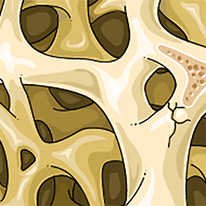Journal
Check out these articles for more information - some general & some technical - we want you to have the information necessary to make good, informed choices.

The goal of all of our REMS posts is for everyone to better understand what REMS is, what information REMS provides to you and the means by which REMS determines that information. Also, we want everyone to understand how REMS differs from DXA even though both methods of bone densitometry are equally valid and accepted means of diagnosing and monitoring osteoporosis. The fundamental difference between REMS and DXA is the type of energy that is used to perform the study - REMS is ultrasound-based and DXA is x-ray-based. Both methods of bone densitometry were developed utilizing the intrinsic properties of their relative energy sources to analyze bone and then provide information that is mathematically analyzed. And, although the information is obtained by different physical methods, the density that is determined by either REMS or DXA is reported according to established WHO standards in both methods. And it is also due to the physical properties of ultrasound, that REMS not only is less susceptible to some of the artifactual errors that can affect DXA results but is also capable of delivering information on the structural properties of bone that are related to bone quality. (DXA has that capability if the TBS software is available). We also want you to better understand how to look at and read the reports that you get when you have a bone densitometry study done. We want to emphasize that we are not trying to teach you how to interpret the report - interpretation of any medical report should be done by a provider that is trained and has experience in analyzing the data on a report, making sense of that data then making recommendations on how to apply that data to treatment recommendations. However, in order to have a better conversation with your provider, an understanding of what the numbers on a bone densitometry report mean would be very helpful. There will be information on both REMS and DXA reports that are similar - BMD (g/cm2) T-score, Z-score and the diagnosis based on the T-score. Both systems have been determined to be a clinically valid means of determining BMD and T-score values and therefore in diagnosing and monitoring osteoporosis. T-scores are the method of using a statistical model to compare a measured BMD (bone density) value to an established “normal” value (please see our earlier FB post that explains all of these terms). However, there will also be differences due to the differences in the technologies that are utilized by the systems. For example, REMS does not need to be routinely calibrated - the piezoelectric crystals in the transducer do not degrade and the occasional software and system upgrades that are done remotely are the only recommendations for unit maintenance. DXA however, uses an x-ray tube that, similar to any light bulb, will have a progressive degradation of its power and a resulting variability in the results and loss of accuracy. Therefore, a complete DXA report should include calibration parameters. Also, the Least Significant Change determined at 95% confidence (LSC) is a measure of the accuracy of a DXA and needs to be calculated at routine intervals (recommended monthly) for all of the examiners using the machine. The details of these calibration requirements are out of the scope of the REMS Discussion Group (thankfully, REMS users don’t have to worry about all that stuff) but all of you DXA users out there can (and should) be reviewing it on the ISCD website - www.iscd.org. Also, it is very important to have a copy of the DXA image page in order to make sure that the positioning of the ROIs and settings were done correctly. Either improper positioning of the ROI or improperly positioned capture boxes will affect the accuracy of the BMD measurement. Now to get to the actual reports! A general and a very basic principle that applies to reviewing not only a densitometry report, but any medical report is that it needs to make sense. The numbers on a report should fall into certain groupings and have a logical consistency. An example of numbers that should cluster are the T-score values that are determined during bone density testing. Except in the situation of uncommon physiological conditions (i.e., transient osteoporosis of pregnancy and lactation) or the presence of pathological processes (disease conditions such as certain cancers, metastatic disease or metabolic bone diseases), the density of bone in an otherwise healthy individual will be relatively uniform and therefore, the T-score values should be concordant (similar) and not discordant (dissimilar) between the different Regions of Interest (ROIs). The average T-score value of the vertebral bodies (L1-L4) and the T-score values of the left and right hips should be close. The ISCD recommends that the T-score values of the spine and hips should be within one Standard Deviation of one another. It has been our experience with REMS that the T-score values obtained at the spine and hips are usually concordant with the differences routinely in the 0.2 - 0.3 range, and usually no more than 0.3 - 0.5 Standard Deviations. It also has been anecdotally noted that when a DXA scan appears to have been well-performed (the image page is available and shows good positioning), and the spine and hip T-scores are concordant, then the REMS T-scores and DXA T-scores tend to also be relatively similar. Many times, it also has been noted that when the DXA hip and spine T-scores are discordant, the REMS measured T-scores will often be more similar to the DXA hip T-scores. In such a case, the DXA spine T-score should be considered an outlier and not considered as a valid measure (back to the basic concept that things should make sense). However, there are times that the REMS results and DXA results will just not match. In those cases, it is the responsibility of the provider to look at the numbers and see which ones make more sense. Also, it is always important to evaluate the other aspects of the reports including the bone quality measures (Fragility Score - we’re getting to that pretty soon), as well as all Relevant Clinical Factors in the medical history to determine treatment recommendations. There are several other patterns that also should be evaluated. And, as with the T-scores, consistency of results is the general concept that applies. The individual T-score values of the vertebral bodies are not relevant to diagnosing or treating osteoporosis - it is the averaged T-score value of all of the vertebral bodies examined (Total). Also, at least two vertebral bodies must have been successfully examined for a clinical diagnosis to be made - the results of a single vertebral body cannot be used for establishing a diagnosis. Therefore, although one individual vertebral body may have a T-score that is “osteoporotic”, the diagnosis of osteoporosis is not correct unless the Total value is less than - 2.5. However, the BMD values of the vertebral bodies should be “looked at” with the expectation that the BMD values will increase from L1 through L4. There are some cases where that pattern does not happen - if the BMD values remain close then the overall results should not be affected by that situation. However, if one of the BMD values is way out of line with the others, it should not be included in the average (and your provider should consider a further diagnostic w/u to determine why the BMD value was out of sequence). Also, there are two BMD values of importance when evaluating the hips. The Femoral Neck (or Neck) BMD and the Total BMD. The Neck BMD should always be smaller than the Total BMD - if it is not, in the vast majority of DXA exams where this occurs it was the study was not done correctly, with an error in positioning being the most likely culprit for the discrepancy (only in a very small percentage of the cases there is the possibility that a physiologic problem with the bone would cause that finding and a w/u by your provider would be indicated). It is our anecdotal experience that we have not seen that situation occur in any of our REMS studies. Trochanteric BMD values are more of a historic relic and are not used in the determination of diagnoses. There is one more clinical application of the BMD values - to determine whether or not there is any change between studies performed in a series. Quantitative analysis (mathematical averaging) is performed using BMD values of the Total spine and the Total hips (not the Neck). Although a qualitative “look” and T-scores between tests can be used as a quick and dirty way to compare studies, actual bone loss/gain calculations should only be done with BMD values. When using REMS, comparisons can be made without regard to where or who did the study - the documented rates between different users and between different EchoS units are extremely small. However, when comparing DXA results it is important to remember that only when the DXA was performed on the same machine and preferably by the same examiner will the quantitative analysis of BMD results really be meaningful. Also, the LSC of DXA is 5% - that means that there has to be at least a 5% change in the BMD in order for the change to be clinically meaningful. The LSC of REMS has been documented to be 0.5-1.0%. Therefore, a change in BMD greater than 1% may be clinically significant. Unless the DXA study happens to include a TBS, then there is no more significant information on a DXA scan. However, the REMS test will provide a Fragility Score which is an assessment of Bone Quality. The Fragility Score is determined from the sound waves that carry information on the structural properties of bone (please see our earlier posts). It is presented on a graph on the second page of the REMS report that depicts a database of individuals who have or who have not sustained a fragility fracture. The fragility score has been shown to be the most sensitive predictor of those individuals who are likely to fracture (true positives) as well as those individuals who are not likely to have a fracture (true negatives). If the FS that is determined by your REMS study places you in the “green zone” of the graph, then the likelihood of fracturing is very small. However, if you are in the FS “red zone” your risk of fracturing is high - the quality of your bone is similar to the quality of the bone of people who have sustained a fragility fracture. The FS is an independent predictor of fracture risk and is both more sensitive and specific than either the REMS-derived or DXA-derived BMD scores. One last important piece of information offered by the REMS assessment is 5-year fracture risk assessment. The Fracture Risk Score can help your provider advise you to fracture risk and recommendations for treatment based on a quantitative score. Please note - the fracture risk is presented as a per-thousand score, not as a percent! Hopefully, this explanation on how the different measured values derived from a bone densitometry can be assessed and understood. Again, the purpose of this post was to provide some insight and education into how your provider may look at the numbers in either a DXA or REMS report - however, you still need your provider to help you interpret the results in order to determine the best bone health plan for you.







